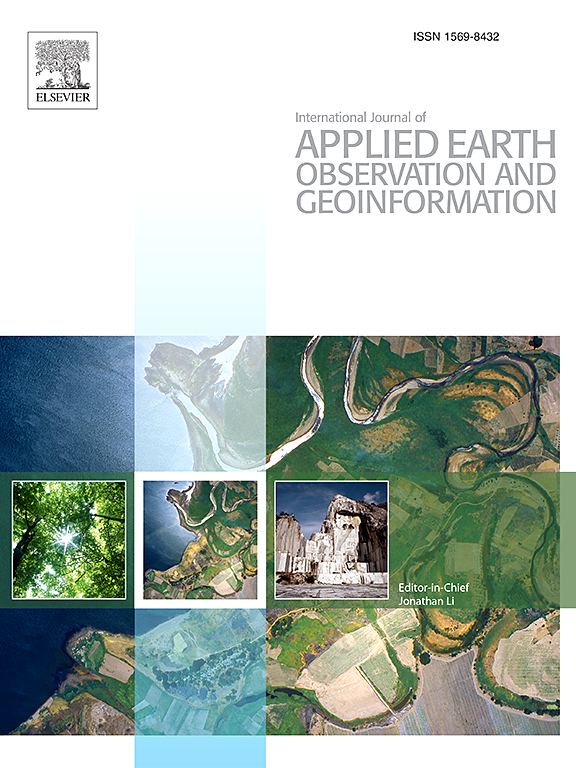基于高光谱卫星影像的可解释CNN模型和光谱指数的新视角——中国最大铁矿群尾矿属性估算与制图:资源潜力与再利用
IF 7.6
Q1 REMOTE SENSING
International journal of applied earth observation and geoinformation : ITC journal
Pub Date : 2025-04-05
DOI:10.1016/j.jag.2025.104512
引用次数: 0
摘要
铁尾矿是主要由铁(Fe)和二氧化硅(SiO2)组成的结晶粉末。铁尾矿理化性质的空间表征对尾矿的优化利用和合理处置具有重要意义。可见光-近红外-短波红外(VIS-NIR-SWIR;350 - 2500nm)光谱学为定量分析尾矿特性提供了一种快速、无损且经济有效的方法。本研究旨在利用实验室光谱和GF-5高光谱图像,量化和绘制中国最大铁群尾矿库中总Fe (TFe)和SiO2含量的空间分布。采用VIS-NIR-SWIR反射光谱仪对11个尾矿坝表面的230个样品进行了扫描。通过多目标规划方法,提出了一种新的谱指数。这个新的指数利用波段比来确定与TFe和SiO2浓度有很强相关性的光谱波段的最佳组合。同时,它最大限度地减少了表面尾矿中水分含量和粒度变化的影响。此外,利用基于实验室光谱的偏最小二乘回归(PLSR)、随机森林(RF)和卷积神经网络(CNN)算法对光谱信息与相关尾砂特性进行校准。通过计算SHaply加性解释(SHAP)值来分析波长在校准建模过程中的贡献。结果表明,反射光谱与TFe含量呈负相关,与SiO2含量呈正相关。R827/(R900 × R2200)计算的三波段光谱指数(TBI)与TFe的相关系数(r)为0.87,R2397/(R776×R900)与SiO2的相关系数(r)为0.70。该方法还最大限度地降低了粒径和含水率对尾矿性质反射光谱的影响。使用实验室光谱的CNN算法对TFe (R2 = 0.74, RPD = 1.79, RMSE = 3.69%, LCCC = 0.74,偏差= -0.41)和SiO2 (R2 = 0.81, RPD = 2.15, RMSE = 1.28%, LCCC = 0.86,偏差= - 0.49)的估计精度最高。采用直接标准化(DS)算法对GF-5高光谱图像进行校正。随后,比较了TBI和CNN模型基于校正后的GF-5图像估计和映射TFe和SiO2含量空间分布的能力。SHAP可以获得CNN模型在尾矿光谱建模中的波长贡献。综上所述,TBI能够快速表征尾矿性质的空间分布,可解释CNN模型可以为基于实验室光谱准确估计尾矿性质提供技术手段。本文章由计算机程序翻译,如有差异,请以英文原文为准。
Estimating and mapping tailings properties of the largest iron cluster in China for resource potential and reuse: A new perspective from interpretable CNN model and proposed spectral index based on hyperspectral satellite imagery
Iron tailings are crystalline powders predominantly composed of iron (Fe) and silicon dioxide (SiO2). Spatially characterizing the physical and chemical properties of iron tailings is greatly important for optimal utilization and proper disposal of tailings. Visible-near infrared-shortwave infrared (VIS-NIR-SWIR; 350–2500 nm) spectroscopy offers a rapid, non-destructive, and cost-effective method for quantitatively analyzing tailings properties. This study aimed to quantify and map the spatial distribution of total Fe (TFe) and SiO2 contents of tailings dams at the largest iron cluster in China using laboratory spectra and GF-5 hyperspectral images. A total of 230 samples were collected from the surface of 11 tailings dams and scanned by a VIS–NIR–SWIR reflectance spectrometer in the laboratory. A novel spectral index was developed through a multi-objective programming methodology. This novel index utilizes band ratios to identify the optimal combination of spectral bands that show a strong correlation with concentrations of TFe and SiO2. Simultaneously, it minimizes the impact of moisture content and particle size variations in surface tailings. In addition, the partial least squares regression (PLSR), random forest (RF) and convolutional neural network (CNN) algorithms based on laboratory spectra were used to calibrate spectral information with associated tailing properties. The contribution of wavelength in the calibration modeling process by calculating SHaply Additive exPlanations (SHAP) values. According to the results, the reflectance spectra were negatively correlated to TFe content and positively correlated to SiO2 content. The three-band spectral index (TBI) calculated by R827/(R900 × R2200) correlated best to TFe with the correlation coefficient (r) of 0.87, while the R2397/(R776×R900) correlated best to SiO2 with r of 0.70. It also minimized the effect of particle size and moisture content on the reflectance spectra of tailings properties. The CNN algorithm with laboratory spectra yielded the highest estimation accuracy for TFe (R2 = 0.74, RPD = 1.79, RMSE = 3.69 %, LCCC = 0.74 and bias = -0.41) and SiO2 (R2 = 0.81, RPD = 2.15, RMSE = 1.28 %, LCCC = 0.86 and bias = −0.49). The direct standardization (DS) algorithm was applied to correct GF-5 hyperspectral image. Subsequently, the ability of TBI and the CNN model was compared for estimating and mapping the spatial distribution of TFe and SiO2 contents based on the corrected GF-5 images. The SHAP could obtain the wavelength contribution of the CNN model in tailings spectral modeling. It can be concluded that the proposed TBI is able to rapidly characterize the spatial distribution of tailings properties, and the interpretable CNN model can provide a technical mean for accurate estimation of tailings properties based on laboratory spectra.
求助全文
通过发布文献求助,成功后即可免费获取论文全文。
去求助
来源期刊

International journal of applied earth observation and geoinformation : ITC journal
Global and Planetary Change, Management, Monitoring, Policy and Law, Earth-Surface Processes, Computers in Earth Sciences
CiteScore
12.00
自引率
0.00%
发文量
0
审稿时长
77 days
期刊介绍:
The International Journal of Applied Earth Observation and Geoinformation publishes original papers that utilize earth observation data for natural resource and environmental inventory and management. These data primarily originate from remote sensing platforms, including satellites and aircraft, supplemented by surface and subsurface measurements. Addressing natural resources such as forests, agricultural land, soils, and water, as well as environmental concerns like biodiversity, land degradation, and hazards, the journal explores conceptual and data-driven approaches. It covers geoinformation themes like capturing, databasing, visualization, interpretation, data quality, and spatial uncertainty.
 求助内容:
求助内容: 应助结果提醒方式:
应助结果提醒方式:


